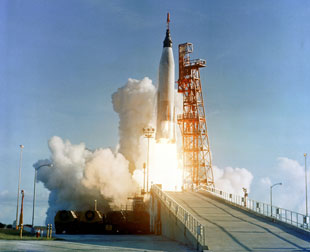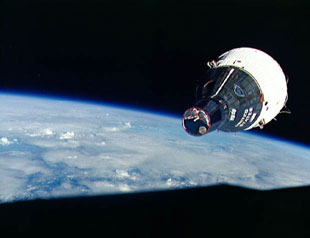|
|

|
'I worked with NASA, not for NASA' (cont'd)
 After serving as a backup to Scott Carpenter, Schirra's Mercury launch came on October 3, 1962, atop an Atlas booster, and he took it very seriously indeed. He considered himself an engineer and pilot, not a poet, and went as far as to ignore the view as much as possible. Schirra was not about to say something nice for public relations purposes. After serving as a backup to Scott Carpenter, Schirra's Mercury launch came on October 3, 1962, atop an Atlas booster, and he took it very seriously indeed. He considered himself an engineer and pilot, not a poet, and went as far as to ignore the view as much as possible. Schirra was not about to say something nice for public relations purposes.
"This is the game that people play. I'll never forget Alan Shepard, on the very first manned American flight, saying something to the effect of, what a beautiful view. I asked him later, did you see anything at all? He said, 'I couldn't see a damn thing through that periscope - but I had to say something nice!' Getting the job done was more my logic. I kind of adopted that philosophy."
Schirra named his spacecraft "Sigma 7", symbolizing engineering precision, and had the opportunity to independently pilot the spacecraft more than any previous flight. He considers that mission the first true piloted orbital flight.
"Glenn was turned around automatically, and was in automatic mode a lot, as was Carpenter. They used up a lot of fuel. So during my flight I put it in what we call a drifting mode, and I moved it back into attitude hold mode with minimum fuel, then put it in what I called 'chimp mode'. That didn't go over too well, but that was the point! It was getting back at the people calling us 'spam in a can'."
Mercury was a very successful program, but to achieve the objective of a lunar landing, there was still much to be done. A vital step towards making a Moon landing would be practicing rendezvous between spacecraft, and the Gemini spacecraft would be the one to do it. After serving as backup commander to Gus Grissom for the first Gemini flight in 1965, Schirra prepared for his second flight, commanding Gemini 6 and piloting it to a rendezvous.
"It was a crucial step. McDivitt and White on Gemini 4 had screwed up badly with rendezvous. Buzz Aldrin tried to get credit for our success, but he had almost screwed us up. Buzz had this academic mind, and realized that there were two ways of doing a rendezvous. One way - his way - was mathematically pure, but if you messed up a little bit, you'd really mess it up. I told him we were not going to do it that way. He was talking about perfection, and perfection is when you're docked - not doing the maneuver. So we looked at a different way - the right way of doing it. We spent a lot of time in simulators. Dean Grimm, a NASA engineer, was one of the guys I worked with. I am indebted to those kinds of people. Of course, Young and Grissom were our backups and they worked on it too - about five or six of us really spent a lot of time on it. McDivitt and White were more involved in doing their spacewalk and other things and didn't really understand what we were doing. They didn't really have time to do that. We were going to do it right."
Things did not go right at first. Schirra and his pilot, Tom Stafford, tried to launch aboard Gemini 6 on October 25, 1965, and rendezvous with an unmanned Agena rocket. However, the Agena exploded, and the launch was scrubbed. The bold decision was made to launch Gemini 7 first, quickly refurbish the pad, and launch Gemini 6 for a rendezvous of both manned spacecraft.
Gemini 7 launched successfully, and on December 12, Schirra and Stafford were ready to try launching again. But something went wrong. The Titan booster's engines ignited, but the rocket did not lift from the pad. Schirra could feel by the seat of his pants that they had not moved.
"I had heard the booster liftoff in Atlas, and this Titan didn't work exactly the same way, so I knew in milliseconds that something had gone wrong, that we had not lifted off. The rule was to eject, to punch us both out. That was kind of a mission rule, and that's another of those rules that was kind of a what-if. And the what-ifs are not all necessarily in a row, or in the proper sequence."
Had Schirra ejected from the spacecraft, it would have been damaged beyond repair, and the rendezvous would not have happened. Schirra chose not to follow that mission rule. Instead, he and Stafford sat through the tense moment, until it was safe to unstrap and exit the spacecraft. Because of that risky decision, they were ready to try again three days later. They launched successfully, and rendezvoused with the waiting Gemini 7.
 "Did I tell you exactly what a rendezvous is? When a man looks across a street and sees a pretty girl, and waves at her, that's not a rendezvous, that's a passing acquaintance. When he walks across the street through the traffic and nibbles on her ear, that's a rendezvous!" "Did I tell you exactly what a rendezvous is? When a man looks across a street and sees a pretty girl, and waves at her, that's not a rendezvous, that's a passing acquaintance. When he walks across the street through the traffic and nibbles on her ear, that's a rendezvous!"
Gemini became Schirra's favorite flying vehicle, closest of all the things he flew to being the ultimate for a test pilot - the harmony of man and machine.
"I appreciated it the most. In Mercury, you couldn't translate. You could just change attitude. But you were actually flying it like a flying machine in Gemini. Apollo was just too big, like flying a big transport airplane, which fighter pilots don't really revere. Gemini was just about the right size - it was not much larger than Mercury, really, and it was optimized for both my right and left hand. I did translation with my left hand, which is a very delicate maneuvre - a bit like when the Shuttle docks with a space station. My left hand was better than my right hand for that."
|
back to News

© 2023 collectSPACE.com All rights reserved.
Questions? E-mail contact@collectspace.com

|
|

|
References:
Wally Schirra with Richard Billings, Schirra's Space, Bluejacket Books,
1995.
Donald Slayton with Michael Cassutt, Deke! U.S. Manned Space: From Mercury to the
Shuttle, Forge Books, 1994.
Walter Cunningham with Mickey Herskowitz, The All-American Boys, Macmillan,
1977.
The Astronauts, We Seven, Simon and Schuster, 1962.
Tom Wolfe, The Right Stuff, Farrar, Strauss and Giroux, 1979.
My thanks to Wally and Jo Schirra, Colin Burgess, Erin French, and Jody Russell of the NASA JSC Media Resource Center, Houston, for their time and assistance with this article.
Copyright for this article is retained by Francis French. A condensed version of this interview has previously appeared in printed form.
Discuss this article in collectSPACE: Messages
|

|

 After serving as a backup to Scott Carpenter, Schirra's Mercury launch came on October 3, 1962, atop an Atlas booster, and he took it very seriously indeed. He considered himself an engineer and pilot, not a poet, and went as far as to ignore the view as much as possible. Schirra was not about to say something nice for public relations purposes.
After serving as a backup to Scott Carpenter, Schirra's Mercury launch came on October 3, 1962, atop an Atlas booster, and he took it very seriously indeed. He considered himself an engineer and pilot, not a poet, and went as far as to ignore the view as much as possible. Schirra was not about to say something nice for public relations purposes. "Did I tell you exactly what a rendezvous is? When a man looks across a street and sees a pretty girl, and waves at her, that's not a rendezvous, that's a passing acquaintance. When he walks across the street through the traffic and nibbles on her ear, that's a rendezvous!"
"Did I tell you exactly what a rendezvous is? When a man looks across a street and sees a pretty girl, and waves at her, that's not a rendezvous, that's a passing acquaintance. When he walks across the street through the traffic and nibbles on her ear, that's a rendezvous!"